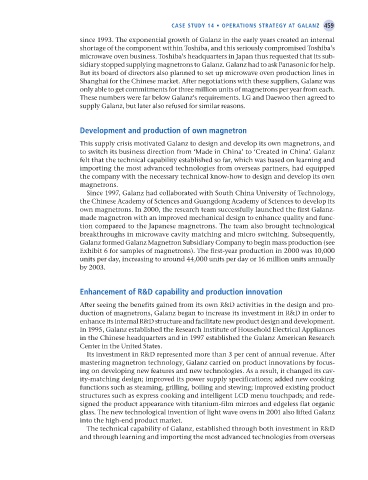Page 484 - Operations Strategy
P. 484
case study 14 • OperatiOns strategy at galanz 459
since 1993. The exponential growth of Galanz in the early years created an internal
shortage of the component within Toshiba, and this seriously compromised Toshiba’s
microwave oven business. Toshiba’s headquarters in Japan thus requested that its sub-
sidiary stopped supplying magnetrons to Galanz. Galanz had to ask Panasonic for help.
But its board of directors also planned to set up microwave oven production lines in
Shanghai for the Chinese market. After negotiations with these suppliers, Galanz was
only able to get commitments for three million units of magnetrons per year from each.
These numbers were far below Galanz’s requirements. LG and Daewoo then agreed to
supply Galanz, but later also refused for similar reasons.
development and production of own magnetron
This supply crisis motivated Galanz to design and develop its own magnetrons, and
to switch its business direction from ‘Made in China’ to ‘Created in China’. Galanz
felt that the technical capability established so far, which was based on learning and
importing the most advanced technologies from overseas partners, had equipped
the company with the necessary technical know-how to design and develop its own
magnetrons.
Since 1997, Galanz had collaborated with South China University of Technology,
the Chinese Academy of Sciences and Guangdong Academy of Sciences to develop its
own magnetrons. In 2000, the research team successfully launched the first Galanz-
made magnetron with an improved mechanical design to enhance quality and func-
tion compared to the Japanese magnetrons. The team also brought technological
breakthroughs in microwave cavity matching and micro switching. Subsequently,
Galanz formed Galanz Magnetron Subsidiary Company to begin mass production (see
Exhibit 6 for samples of magnetrons). The first-year production in 2000 was 10,000
units per day, increasing to around 44,000 units per day or 16 million units annually
by 2003.
enhancement of r&d capability and production innovation
After seeing the benefits gained from its own R&D activities in the design and pro-
duction of magnetrons, Galanz began to increase its investment in R&D in order to
enhance its internal R&D structure and facilitate new product design and development.
In 1995, Galanz established the Research Institute of Household Electrical Appliances
in the Chinese headquarters and in 1997 established the Galanz American Research
Center in the United States.
Its investment in R&D represented more than 3 per cent of annual revenue. After
mastering magnetron technology, Galanz carried on product innovations by focus-
ing on developing new features and new technologies. As a result, it changed its cav-
ity-matching design; improved its power supply specifications; added new cooking
functions such as steaming, grilling, boiling and stewing; improved existing product
structures such as express cooking and intelligent LCD menu touchpads; and rede-
signed the product appearance with titanium-film mirrors and edgeless flat organic
glass. The new technological invention of light wave ovens in 2001 also lifted Galanz
into the high-end product market.
The technical capability of Galanz, established through both investment in R&D
and through learning and importing the most advanced technologies from overseas
Z14 Operations Strategy 62492.indd 459 02/03/2017 13:59

